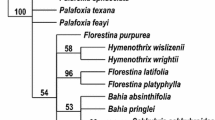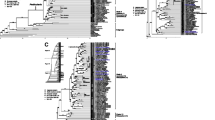Abstract
A preliminary phylogenetic analysis is presented forLomariopsis based on sequence data from the chloroplast intergenic spacertrnL-trnF. The analysis includes 27 (60%) of the approximately 45 species in the genus. A strict consensus of six most parsimonious trees supports two main clades—theSorbifolia-group and theJapurensis-group—previously proposed based on heteroblastic leaf development. TheSorbifolia-group is entirely neotropical and includes all the Antillean species. The species in this clade had either smooth or crested spores, but the tree was ambiguous whether these spore types define two separate clades. TheJapurensis-group consists of two clades, one primarily neotropical and the other entirely paleotropical. Within the neotropical clade nests a clade of two African species, which have long-spiny spores typical of the neotropical clade and unlike those found in the African-Madagascan clade. The occurrence of these two species in Africa is best explained by longdistance spore dispersal of their ancestral species from the neotropics to Africa. Within the paleotropical clade of theJapurensis-group, a clade of three African species is nested among seven species from Madagascar (all the species from that island). Within the genus as a whole, a derived character—the abortion of the rachis apex and its replacement by the distal lateral pinna assuming a terminal position—was found to have evolved separately in each of the four species with this kind of leaf apex. A scanning electron microcope study of the spores revealed five types, and a transformation series for these different types is proposed. Characters of spore morphology and heteroblastic leaf development agreed with many of the clades in the phylogenetic tree. This study represents the first phylogeny for the genus.
Resumen
Se presenta un análisis filogenético preliminar paraLomariopsis basado en datos de secuencias del espaciador intergenético del cloroplastotrnL-trnF. El análisis incluye 27 (60%) de las aproximadamente 45 especies del género. Un consenso estricto de seis árboles más parsimoniosos soporta dos clados principales—el grupoSorbifolia y el grupoJapurensis—previamente propuestos en análisis basados en el desarrollo heteroblástico de las hojas. El grupoSorbifolia es completamente neotropical e incluye todas las especies de las Antillas. Las especies de este clado presentan esporas lisas o crestadas, sin embargo el árbol fue ambiguo con respecto a si este tipo de esporas define dos clados separados. El grupoJapurensis está compuesto por dos clados, uno principalmente neotropical y otro completamente paleotropical. Dentro del clado neotropical se encuentra anidado un clado de dos especies Africanas, que poseen un tipo de esporas con espinas largas que es típico del clado neotropical y diferente al encontrado en el clado compuesto por especies Africanas y de Madagascar. La mejor explicación para la presencia de estas dos especies en Africa es dispersión a largas distancias de esporas de sus especies ancestrales desde el neotrópico hacia África. Dentro del clado paleotropical del grupoJapurensis, un clado de tres especies africanas se encuentra anidado entre siete especies de Madagascar (la totalidad de las especies de esta isla). Para el género completo un carácter derivado, el aborto del ápice del raquis y su reemplazo por la pinna lateral distal asumiendo una posición terminal, se encontró que ha evolucionado por separado en cada una de las cuatro especies con esta clase de ápice de la hoja. Un estudio de microscopio electrónico de barrido de las esporas reveló cinco tipos, se propone una serie de transición para estos diferentes tipos. Los caracteres de la morfología de la espora y del desarrollo heteroblástico de la hoja proporcionaron soporte adicional para muchos de los clados en el árbol filogenético. Este estudio representa la primera filogenia del género.
Similar content being viewed by others
Literature Cited
Collinson, M. E. 2001. Cainozoic ferns and their distribution. Brittonia 53: 173–235.
DeSalle, R., G. Giribert &W. Wheeler. 2002. Techniques in molecular systematics and evolution. Birkhäuser Verlag, Basel-Boston-Berlin.
Doyle, J. J. &J. L. Doyle. 1987. A rapid DNA isolation procedure for small quantities of fresh leaf tissue. Phytochem. Bull. Bot. Soc. Amer. 19: 11–15.
Felsenstein, J. 1985. Confidence limits on phylogenies: an approach using the bootstrap. Evolution 39: 783–791.
Holttum, R. E. 1932. OnStenochlaena, Lomariopsis andTeratophyllum in the Malayan region. Gard. Bull. Straits Settlem. 5: 245–316.
—. 1938. The genusLomariopsis in Madagascar and the Mascarene Islands. Notul. Syst. (Paris) 8: 48–62.
—. 1940. New species ofLomariopsis. Bull. Misc. Inform. Kew 1939: 613–628.
—. 1966. The generaLomariopsis, Teratophyllum, andLomagramma in the islands of the Pacific and Australia. Blumea 14: 215–223.
—. 1978.Lomariopsis group. Flora Malesiana, Ser. 2, Pteridophyta 1(4): 255–330.
Kramer, K. U., P. S. Green &A. Goetz. 1990. The families and genera of vascular plants, I. Pteridophytes and gymnosperms. Springer-Verlag. Berlin.
Lorence, D. H. 1978. A new species ofLomariopsis from Mauritius. Fern Gaz. 11: 367–368.
Moran, R. C. 2000. Monograph of the neotropical species ofLomariopsis (Lomariopsidaceae). Brittonia 52: 55–111.
— 2001. Phytogeographic relationships between neotropical and African-Madagascan pteridophytes. Brittonia 53: 304–351.
— 2004.Lomariopsis × farrarii, a new hybrid from Costa Rica betweenL. japurensis andL. vestita (Lomariopsidaceae). Brittonia 56: 205–209.
Philippe, H. 1993. MUST, a computer package of Management Utilities for Sequences and Trees. Nucleic Acids Research 21: 5264–5272.
Rouhan, G., J.-Y. Dubuisson, F. Rakotondrainibe, T. J. Motley, J. T. Mickel, J-N. Labat &R. C. Moran. 2004. Molecular phylogeny of the fern genusElaphoglossum (Elaphoglossaceae) based on chloroplast non-coding DNA sequences: contributions of species from the Indian Ocean area. Molecular Phylogenetics and Evolution 33: 745–763.
Skog, J. E. 2001. Biogeography of Mesozoic leptospo-rangiate ferns related to extant ferns. Brittonia 53: 236–269.
Struwe, L., M. Thiv, J. W. Kadereit, A.S.-R. Pepper, T. J. Motley, P. J. White, J. H. E. Rova, K. Potgieter &V. A. Albert. 1998.Saccifolium (Saccifoliaceae), an endemic of Sierra de La Neblina on the Brazilian-Venezuelan frontier, is related to a temperate-alpine lineage of Gentianaceae. Harvard Papers in Botany 3: 199–214.
Swofford, D. L. 2002. PAUP* phylogenetic analyses using parsimony (*and other methods), Version 4. Sinauer Associates, Sunderland, Massachusetts.
Taberlet, P., L. Gielly, G. Pautou &J. Bouvet. 1991. Universal primers for amplification of three non-coding regions of chloroplast DNA. Plant Molecular Biology 17(5):1105–1109.
Tardieu-Blot, M.-L. 1960. Polypodiacées (sensu lato)in Flore de Madagascar et des Comores. (H. Humbert, ed.), Paris.
Thompson, J. D., T. J. Gibson, F. Plewniak, F. Jeanmougin &D. G. Higgins. 1997. The ClustalX windows interface: flexible strategies for multiple sequence alignment aided by quality analysis tools. Nucleic Acids Research 24: 4876–4882.
Tryon, A. F. &B. Lugardon. 1991. Spores of the Pteridophyta. Springer-Verlag, New York
Author information
Authors and Affiliations
Corresponding author
Rights and permissions
About this article
Cite this article
Rouhan, G., Garrison Hanks, J., McClelland, D. et al. Preliminary phylogenetic analysis of the fern genus Lomariopsis (Lomariopsidaceae). Brittonia 59, 115–128 (2007). https://doi.org/10.1663/0007-196X(2007)59[115:PPAOTF]2.0.CO;2
Issue Date:
DOI: https://doi.org/10.1663/0007-196X(2007)59[115:PPAOTF]2.0.CO;2




